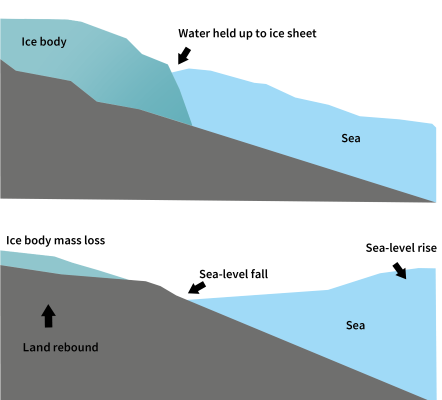© Pint of Science, 2025. All rights reserved.
Cast your mind back to secondary school science where we learnt about the different states of water. It’s a fairly simple concept - when an ice cube is warmed, it melts and turns into a liquid. When it gets sufficiently cold again it will freeze back into ice. Simple! Just like ice cubes, the same principles apply to the ice on Earth - glaciers, ice caps and ice sheets. As the world gets warmer, these ice bodies melt and become liquid. However, things start to get a bit more complicated … Contrary to what you might think when ice caps and sheets melt, the surrounding sea level does not get higher. In fact, it actually falls.
Scientists were able to map and model this bizarre phenomenon, called sea-level fingerprinting, at the beginning of the 21st century in a ground-breaking Nature paper. Researchers showed that when Arctic glaciers and the Greenland ice sheet melted, the corresponding sea-level rise was not in the vicinity, but instead occurred thousands of kilometres away around the upper and lower middle regions of the planet, known as the mid and low latitudes. Since that first report, many other scientists have found similar results in their modelling, all showing similar patterns of ice melt around the globe. In 2017, researchers at NASA’s Jet Propulsion Laboratory in California, and colleagues from the University of California, Irvine, confirmed what the modellers had suspected using the GRACE satellite, finding direct proof of this bizarre phenomenon in the ocean. All of this showed melting in Greenland was actually causing a big headache for those living in places like Indonesia, South America and South Africa. But why?
To understand, we need to turn to gravity. Gravity is a force which keeps everything in space together and draws everything towards its centre - a phenomenon termed a “gravitational pull”. Any object with a mass has a pull. This pull causes the planets and moons within our solar system to orbit around the sun and keeps satellites in orbit around Earth. There are two more basic gravity rules we need to know here. Firstly, the larger the mass, the larger the gravitational pull. Secondly the closer an object is to the mass, the stronger the pull upon that object will be. So, in a nutshell, anything big will exert a large gravitational pull on an object, and anything located close to that big mass will be pulled in tight! As an ice body has a mass, it has its own gravitational pull. When that body melts, it loses mass, and its gravitational pull weakens. Where the sea had been held up in tight retention to the ice sheet margins, now the ice body loses its grip on the surrounding water, causing a sea-level fall in the areas around the ice body. The water is re-distributed further away, causing a sea-level rise in and around the low and mid-latitudes where the water mass of melted ice is redistributed over large areas.
Not only is modern-day ice melt having an effect on the sea level around Greenland, but even today, we are still feeling the effects of the last ice age that ended around 11,500 years ago. During the last ice age, the ice sheet of Greenland grew and became heavier, pressing down onto the land - think of it like pressing your finger into one of those giant marshmallows. Because the land effectively sunk under the weight of the ice, the sea level appeared to rise relative to the land (even though there is actually less water in the ocean because it’s now locked up in the ice sheet!). Now as the ice sheet melts, the land springs back up (like when you take your finger off said marshmallow) and so the sea appears to fall. Therefore, both the modern-day effect of the gravitational weakening and the rebounding of the land from the last ice age couple to create a seemingly even bigger sea-level fall around Greenland.

Gravitational pull of an ice sheet on the surrounding sea
So what does this all mean? Well, ice sheets and glaciers will continue to melt as our world gets warmer under human-induced climate change. More of this meltwater is going to be re-distributed to the low and mid-latitudes, causing a rise in sea levels elsewhere in the world on top of a multitude of other climate-induced problems. There is also the effect of the Antarctic ice sheet and Southern Hemisphere glaciers such as those located in Chile and Patagonia that have the same effect as Northern Hemisphere ice bodies but from the other side of the world. So, if you’re thinking of buying a beach house somewhere around the Caribbean, Zanzibar or the Maldives, you may want to reconsider and go for a chalet in the poles!
About the Author
Sophie Williams is a third-year PhD student at the University of York working within the Department of Environment and Geography. Sophie is interested in past climate and environmental change of the Earth and how we can learn from past climatic events to understand the environment of the present and the future. She currently works on reconstructing sea-level change of the 19th and 20th century to see whether Arctic ice melt could have been responsible for a rapid rise in sea level in the 20th century before human-induced effects took precedence on the climate. To do this, she looks at sea-level change in Australia, an area that should be suitable to detect a sea-level fingerprint of Greenland ice melt. Sophie grew up in a working-class town and is a first-generation academic so passionately believes that scientific research must be accessible to all in order for its importance to be truly conveyed and strives to do this with her work. “Nothing in science has any value to society if it is not properly communicated” - Anne Rowe. If you want to learn more about Sophie’s research you can find her on twitter @sophielwill_ or at sophielaurenwilliams.wordpress.com.
Image Credit: Lauren Rawlins @Lauren_Rawlins1.


